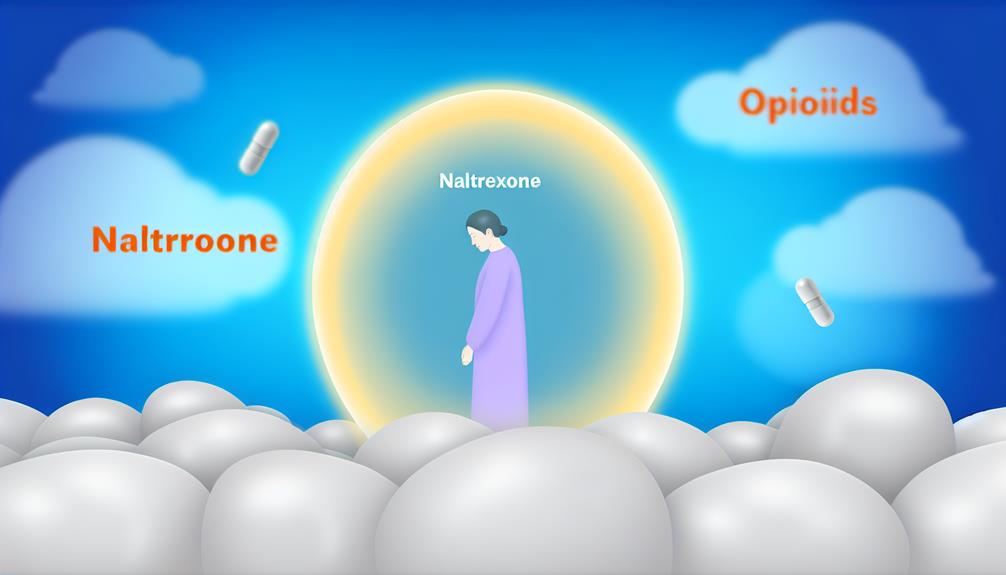Are you tired of the devastating effects of opioid overdoses? Looking for effective solutions to prevent such tragedies? Well, look no further.
In this discussion, we will explore the six best medication-assisted treatments that have been proven to save lives. From the life-saving Naloxone to the extended-release option of Vivitrol, these treatments offer hope and a way forward.
So, let's dive into the world of medication-assisted treatments that are revolutionizing overdose prevention.
Naloxone: The Life-Saver Medication

Naloxone, a life-saving medication, is a crucial tool in preventing overdose deaths. Its availability and accessibility are pivotal in the fight against the opioid crisis. Naloxone can reverse the effects of an opioid overdose by quickly binding to the opioid receptors in the brain, effectively restoring normal breathing patterns. This fast-acting medication can mean the difference between life and death.
Ensuring naloxone's availability and accessibility is essential. Many states have implemented standing order laws, allowing anyone to purchase naloxone from a pharmacy without a prescription. This is a significant step forward in making naloxone easily accessible to those who need it. Additionally, community-based naloxone distribution programs have been successful in reaching vulnerable populations, such as people who use drugs and their loved ones.
However, accessibility alone isn't enough. Naloxone training and education are equally important. Providing comprehensive training on recognizing the signs of an overdose, administering naloxone, and performing rescue breathing can empower individuals to save lives when faced with an overdose situation. Community organizations, healthcare providers, and public health agencies play a crucial role in offering these trainings and spreading awareness about naloxone's life-saving potential.
Methadone: A Long-Standing Treatment Option
Methadone has been a widely recognized and extensively used treatment option for opioid use disorder for several decades. It's a long-acting opioid agonist that helps to reduce cravings and withdrawal symptoms, enabling individuals to stabilize their lives and engage in treatment.
Here are some important points to consider when discussing methadone as a treatment option:
- Long-term effectiveness: Research has shown that methadone maintenance treatment can be highly effective in reducing opioid use, criminal activity, and the risk of overdose. It has been associated with improved social functioning, increased retention in treatment, and reduced mortality rates.
- Alternative treatments: While there are alternative medications available for opioid use disorder, such as buprenorphine and naltrexone, methadone remains a valuable treatment option for many individuals. It's particularly beneficial for those with a long history of opioid dependence or who haven't responded well to other medications.
- Individualized approach: The decision to pursue methadone treatment should be made on an individual basis, taking into consideration factors such as the severity of the addiction, medical history, and treatment goals. It's important to work closely with a healthcare provider to determine the most appropriate treatment approach.
Methadone has stood the test of time as a reliable and effective treatment option for opioid use disorder. It offers long-term effectiveness and can be a valuable alternative for those who haven't found success with other treatments. Remember, every individual's journey is unique, and finding the right treatment approach is crucial for their recovery.
Buprenorphine: A Versatile Medication
Buprenorphine is a versatile medication that offers several benefits in the treatment of opioid use disorder. It's highly effective in preventing overdoses by reducing cravings and withdrawal symptoms, allowing individuals to stabilize and regain control of their lives.
Studies have shown that buprenorphine not only improves retention in treatment but also reduces illicit opioid use, criminal activity, and risk of HIV transmission.
Benefits of Buprenorphine
One highly effective medication for overdose prevention and treatment is buprenorphine, which offers a range of benefits for individuals struggling with opioid use disorder. Buprenorphine has a well-established safety profile, making it a reliable option for long-term use. Its availability in different formulations, such as sublingual tablets and transdermal patches, allows for flexibility in treatment approaches.
- Buprenorphine reduces the risk of fatal opioid overdose by suppressing withdrawal symptoms and cravings, helping individuals maintain abstinence.
- It can be prescribed in primary care settings, improving access to treatment and reducing the stigma associated with specialized addiction clinics.
- Buprenorphine's long-acting properties provide sustained relief, allowing individuals to focus on other aspects of their recovery journey.
With its safety, accessibility, and efficacy, buprenorphine offers hope and a path towards recovery for those struggling with opioid use disorder.
Buprenorphine's Effectiveness in Prevention
To effectively prevent opioid overdose, it's crucial to understand the versatile effectiveness of buprenorphine as a medication-assisted treatment.
Buprenorphine has emerged as a powerful tool in combating opioid addiction, and its safety profile makes it an attractive option for overdose prevention. Studies have shown that buprenorphine reduces the risk of fatal overdose by stabilizing and reducing opioid cravings.
Unlike other medications, buprenorphine has a lower risk of respiratory depression, making it a safer choice for individuals with respiratory issues. Moreover, buprenorphine's accessibility is another significant advantage. It can be prescribed in office-based settings, allowing for convenient and timely access to treatment.
This is particularly important in addressing the opioid epidemic, as it ensures that individuals seeking help can receive the necessary care promptly. By understanding buprenorphine's safety profile and accessibility, we can better utilize this medication to prevent opioid overdose and save lives.
Suboxone: Combining Buprenorphine and Naloxone
Suboxone, a combination of buprenorphine and naloxone, has proven to be an effective medication-assisted treatment for opioid addiction.
Buprenorphine, a partial opioid agonist, helps to alleviate withdrawal symptoms and cravings, while naloxone serves as an opioid antagonist, discouraging misuse.
This combination therapy not only aids in reducing the risk of overdose, but also provides individuals with the opportunity to engage in comprehensive addiction treatment and regain control of their lives.
Efficacy of Suboxone
The combination of Buprenorphine and Naloxone in Suboxone has shown significant efficacy in the treatment of opioid addiction. Suboxone, when used at the appropriate dosage, can effectively reduce cravings and withdrawal symptoms, allowing individuals to focus on their recovery journey. It offers a balanced approach by stimulating the opioid receptors with Buprenorphine while also blocking the effects of other opioids with Naloxone. This combination helps to prevent relapse and overdose, providing a lifeline for those struggling with addiction.
Suboxone provides a sense of stability, allowing individuals to regain control of their lives. The medication helps to alleviate the physical discomfort associated with opioid withdrawal, promoting a smoother recovery process. Suboxone reduces the risk of overdose by blocking the effects of other opioids, ensuring individual safety.
Mechanism of Action
After understanding the efficacy of Suboxone in treating opioid addiction, it's important to explore the mechanism of action behind this medication's combination of Buprenorphine and Naloxone.
Suboxone is a medication-assisted treatment that combines two active ingredients: Buprenorphine and Naloxone.
Buprenorphine is a partial opioid agonist, meaning it activates opioid receptors in the brain but with a weaker effect compared to full agonists like heroin or oxycodone. This helps alleviate withdrawal symptoms and cravings without producing the same level of euphoria.
Naloxone, on the other hand, is an opioid receptor antagonist that blocks the effects of opioids. It's added to Suboxone to deter misuse by injection, as it can precipitate withdrawal symptoms if injected.
The combination of these two medications enhances the clinical efficacy of Suboxone by providing a balanced approach to opioid addiction treatment.
Benefits of Combination Therapy
Combining Buprenorphine and Naloxone in Suboxone offers a range of benefits for individuals undergoing medication-assisted treatment for opioid addiction. This combination therapy has proven to be highly effective in helping patients overcome their addiction and achieve long-term recovery.
Here are three significant benefits of combining Buprenorphine and Naloxone:
- Enhanced safety: Naloxone, an opioid antagonist, helps prevent misuse and abuse of Suboxone. It blocks the effects of opioids, reducing the risk of overdose and promoting safety during the treatment process.
- Reduced cravings and withdrawal symptoms: Buprenorphine, a partial opioid agonist, helps alleviate cravings and withdrawal symptoms, making it easier for individuals to abstain from illicit opioids. This relief allows patients to focus on their recovery without being overwhelmed by intense cravings.
- Improved adherence to treatment: The combination of Buprenorphine and Naloxone in Suboxone simplifies the treatment process, as patients only need to take one medication. This convenience promotes better adherence to the treatment plan, increasing the likelihood of successful recovery outcomes.
Vivitrol: The Extended-Release Option
If you're considering medication-assisted treatment for overdose prevention, Vivitrol provides an extended-release option that may be worth exploring. Vivitrol is a brand name for naltrexone, a medication that works by blocking the effects of opioids in the brain. Unlike other forms of naltrexone, which are taken orally on a daily basis, Vivitrol is administered as a once-monthly injection. This extended-release formulation offers several benefits for individuals seeking to prevent overdose.
One of the main advantages of Vivitrol's extended-release formulation is the convenience it provides. Instead of having to remember to take a pill every day, you only need to receive an injection once a month. This can be especially helpful for individuals who struggle with adherence to medication regimens or who've a busy lifestyle that makes it difficult to remember to take a daily pill.
Additionally, the extended-release mechanism of Vivitrol ensures a consistent and steady release of naltrexone over the course of the month. This helps to maintain a stable level of medication in the body, which can improve treatment outcomes and reduce the risk of relapse.
Naltrexone: Blocking the Effects of Opioids

For individuals seeking to block the effects of opioids and continue their medication-assisted treatment for overdose prevention, the next subtopic focuses on naltrexone, an effective option that can help maintain stability and reduce the risk of relapse.
- Naltrexone offers a way to block the effects of opioids, preventing individuals from experiencing the pleasurable or euphoric sensations associated with their use. This can be a game-changer for those trying to break free from the cycle of addiction, as it removes the incentive to use opioids.
- By blocking opioids from binding to their receptors in the brain, naltrexone helps reduce the risk of overdose. This is especially important for individuals who may be in situations where they're exposed to opioids, such as in social settings or through relapse triggers. Naltrexone acts as a protective barrier, preventing the opioids from causing harm.
- Naltrexone can contribute to overdose prevention by helping individuals stay engaged in their treatment. By reducing cravings and withdrawal symptoms, it allows individuals to focus on their recovery journey and make progress towards a healthier and more fulfilling life.
Choosing naltrexone as part of your medication-assisted treatment can be a powerful tool in blocking the effects of opioids and preventing overdose. Talk to your healthcare provider to see if naltrexone is the right option for you. Remember, you don't have to face this alone – there's support available to help you on your path to recovery.








